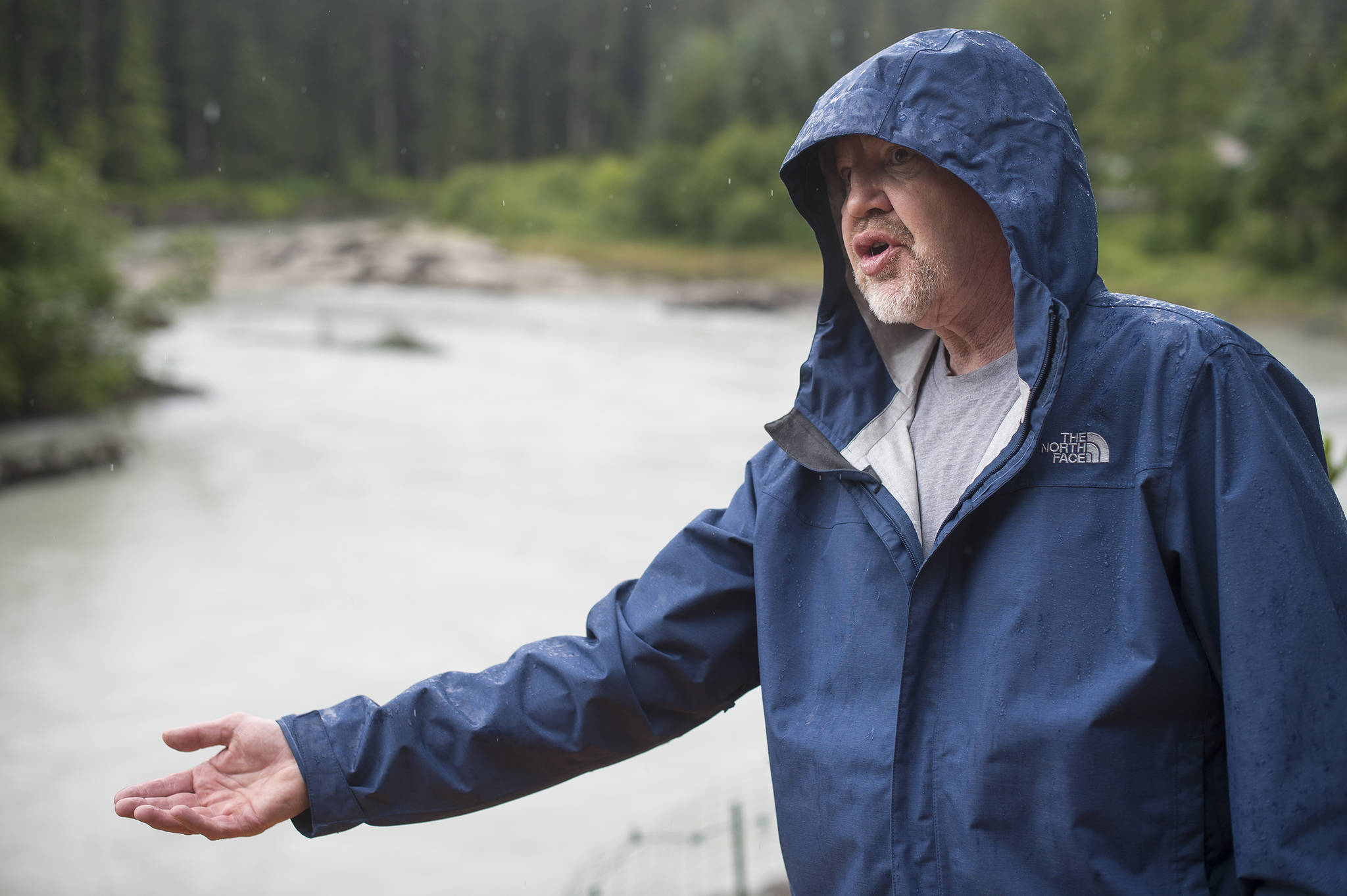Just four years ago, Norman Staton had about 15 feet between his deck and his backyard fence.
Now his backyard has disappeared, and he’s holding out hope that help can come before he has to start cutting up his deck. With his house backed up against the constantly changing Mendenhall River, floods in recent years and a rapidly descending riverbed have eroded the banks.
Just one or two steps off Staton’s back deck would send a person tumbling down the steep bank of the river, which changes with every glacial flood known as the jökulhlaup.
The City and Borough of Juneau contacted the Natural Resources Conservation Service (NRCS) in 2013 to search for a solution to the erosion. The NRCS is putting a plan together, but it’s one that would cost 28 homeowners along Meander Way tens of thousands of dollars.
Not all of the homeowners along the road face the same extreme situation as Staton, and some of them don’t want to pay so much money for a problem that isn’t affecting them at the moment.
“It’s a horrible situation we’re all in,” Staton said Thursday.
The CBJ Assembly Committee of the Whole discussed the issue Wednesday night, not reaching a decision on which direction to go. Committee members sympathized both with those whose houses are in danger and those who will have to pay an exorbitant amount for a problem that’s still years away for them. The committee agreed to have city staff further evaluate the options.
NRCS would secure funds from the federal government to cover 75 percent of this project, which would put netting and rocks called rip rap up to protect the riverbank. With the project estimated to cost at least $7.7 million, the local government will still have to come up with $1.9 million, plus administrative and permit costs.
The current estimation for the total cost of the project is $2.2 million, which would mean each household would pay $78,500. In a memo from CBJ Engineering and Public Works Director Roger Healy sent to the committee, Healy explained that the estimate could rise to $2.8 million ($105,000 per household) by the end of the project.
CBJ’s current position is that it will serve only as a “conduit” for funds, Healy explained. This means that the city would pay the initial amount needed to carry out the project but the homeowners would then pay the city after the project is completed. Homeowners would be able to pay the city back over the next 10 or 15 years.
The city doesn’t own the affected property, and therefore has no direct benefit from the NRCS project. With the city located in an area that has avalanches, floods, landslides and numerous other natural hazards, Healy said it’s not possible for the city to pay for every project.
“The city is not responsible for every natural process, I guess is one way to put it,” Healy said Thursday.
In April, the CBJ surveyed the homeowners on Meander Way, with 20 of the 25 residents responding that they want to go through with the NRCS plan and pay the estimated $78,000. The dissenters were loud and clear at Wednesday’s meeting, however.
Six Meander Way residents spoke at Wednesday’s meeting, with two (including Staton) in favor of moving forward with the project and four speaking against the project. Whether they explained that they moved there without knowing about the erosion issues or that they’ve been trying to sell their house to no avail, their words weighed heavily on the committee members.
One of the main issues at hand Wednesday was that of equal benefit. Assembly members Maria Gladziszewski and Jerry Nankervis both argued that if each homeowner is paying the same amount of money, they should all be benefit the same amount.
Nankervis drew a comparison to other neighborhood improvement projects, referred to as Local Improvement Districts (LIDs) and how this one differed.
“This isn’t the same as a normal LID, where if you pave a street, everyone drives down it,” Nankervis said. “If we plumb a street, everybody down that street gets water. This is radically different, for a lot more money, and I have some serious concerns.”
There was talk about some homeowners paying more than others due to an estimation of how much each homeowner would benefit, but this is hard to quantify. Staton also explained Thursday that the installation cost on every property would be basically the same, based on the NRCS estimate.
Assembly members Loren Jones and Jesse Kiehl pointed out that delaying a decision on how to move forward with this progress would further endanger the homeowners. Jones argued that delaying on making a decision could also cause the project to miss out on federal funding, and said the Assembly needs to “get our act together” and make a decision.
Kiehl pointed to the Mat-Su Borough, where houses are crumbling into the river due to erosion. In 2010, the Mat-Su Borough issued a press release entitled “Addressing erosion not easy,” which explained that there are numerous factors that go into decisions around erosion prevention, mostly those of securing funds.
Juneau’s city officials are also finding that addressing erosion is difficult, and Kiehl argued that they need to take action before it’s too late.
“I think,” Kiehl said, “that cities that wash into rivers don’t get very far.”
• Contact reporter Alex McCarthy at alex.mccarthy@juneauempire.com.

